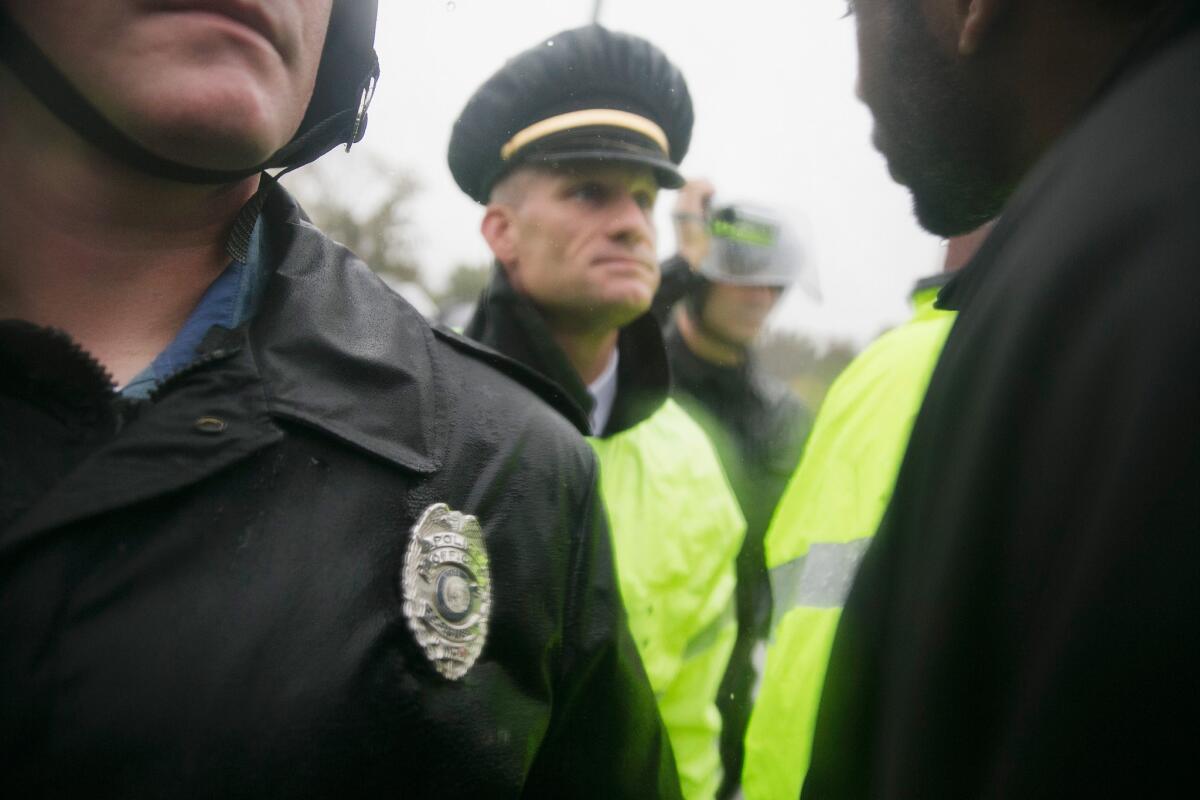Op-Ed: When police moonlight in their uniforms

- Share via
The facts are still emerging about Wednesday’s fatal shooting of 18-year-old Vonderrit Myers Jr. by an off-duty St. Louis police officer, but one topic deserves attention no matter what. The officer involved in the shooting was off-duty, but he was working for a private security firm while wearing his public police uniform. This second job wasn’t secret. The St. Louis Police Department approved it.
The officer involved in the fatal shooting was working for the St. Louis-based CGI Security, and he may have been assigned to patrol the Flora Place Community Improvement District, a St. Louis neighborhood whose residents have agreed to a special tax assessment for security and other services. So extra tax funds go to a private security firm to pay an off-duty public police officer to patrol public streets in his police department uniform. If you’re confused, you should be.
And while the particular taxpayer arrangement in St. Louis may be unusual, the broader practice of privately hiring public police in their police uniforms isn’t. Some police departments, such as St. Louis, have formal programs that set pay rates and approve potential employers. In St. Louis, such moonlighting deals may be a response to a downsized public police department that is little more than half as big as it was in 1970.
The Los Angeles Police Department and the New York Police Department, the largest in the country, are among the forces that have a formal program to oversee public police officers, in uniform, who are paid as private security. You might have seen such LAPD offices at a Dodgers or Lakers game, or at the Hollywood Bowl. In 2006, the Los Angeles City Council approved the rules that required private corporations interested in hiring off-duty police officers in uniform to contract directly with the department rather than with individual officers, as had been the case.
The Police Commission wanted greater departmental control over officers’ private employment. But the rule change also gives the private employment of officers in uniform the department’s stamp of legitimacy and support.
Should police officers on the public payroll also work for private companies while in uniform? It’s clear why private companies are eager to hire them. A police uniform is a symbol of government authority and carries with it the potential to employ legally authorized, even deadly, force.
During the civil lawsuit filed after the brutal beating of Bryan Stow in the Dodger Stadium parking lot in 2011, the team’s head of security, Shahram Ariane, explained why the Dodgers hired uniformed off-duty LAPD officers, who are more expensive than security guards, or even off-duty police in polo shirts: “People behave differently when dealing with a uniformed police officer — albeit off-duty but unbeknownst to them.”
More than 25 years ago, a Department of Justice study noted that the practice caused “understandable” citizen confusion. That misunderstanding may be good for business, but it’s of questionable value for communities and their relationship with the police and the law.
That’s especially true when private employers’ interests and priorities may not coincide with the public interest. “Quality of life” policing focuses police attention on minor offenses so that more serious crimes have fewer opportunities to flourish. But what happens when an officer’s private employer has a different idea of “disorder” than what the public police department does? Should the definition of community standards simply be a matter of who pays the officers?
Moonlighting police may face clear conflicts of interest. When San Jose Police Department officers arrived at the home of San Francisco 49ers player Ray McDonald to respond to a now-infamous domestic violence call, they found one of their own already there, in uniform but off-duty and employed, according to the San Jose Mercury News, as part of the team’s security force, as “protective detail” for the athletes. The complications prompted by that officer’s presence may have been a significant factor in the delayed receipt of the case by the Santa Clara County district attorney’s office, sources told the newspaper. On Friday, the San Jose Police Department announced it would suspend all off-duty work with the 49ers.
How many police departments around the country have these arrangements? Because there is no regular collection of national data on police moonlighting, it’s hard to say. But this direct intermingling of private and public raises unique and troubling questions if public police are to be responsive to the communities they serve, and not just to parts of them.
The fatal shooting in St. Louis, just miles from the spot where Ferguson, Mo., police officer Darren Wilson fatally shot an unarmed Michael Brown, will surely prompt more questions about police use of excessive force, racial disparities in policing, and police accountability. It’s also an opportunity to question whether public policing is a public good or just another market commodity.
Elizabeth E. Joh is a law professor at the UC Davis School of Law and on Twitter @elizabeth_joh.
Follow the Opinion section on Twitter @latimesopinion
More to Read
A cure for the common opinion
Get thought-provoking perspectives with our weekly newsletter.
You may occasionally receive promotional content from the Los Angeles Times.









